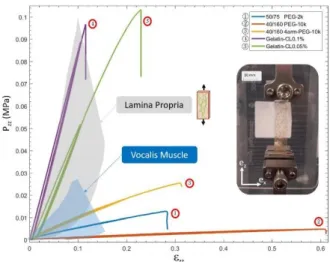HAL Id: hal-02550571
https://hal.archives-ouvertes.fr/hal-02550571
Submitted on 22 Apr 2020
HAL is a multi-disciplinary open access
archive for the deposit and dissemination of
sci-entific research documents, whether they are
pub-lished or not. The documents may come from
teaching and research institutions in France or
abroad, or from public or private research centers.
L’archive ouverte pluridisciplinaire HAL, est
destinée au dépôt et à la diffusion de documents
scientifiques de niveau recherche, publiés ou non,
émanant des établissements d’enseignement et de
recherche français ou étrangers, des laboratoires
publics ou privés.
Multi-axial mechanical properties of hydrogel-based
materials upon finite strains: towards the design of
tailored vocal-fold composite replicas
Hamid Yousefi-Mashouf, Daniel Ferri-Angulo, Lucie Bailly, Jérôme Sohier,
Laurent Orgéas, Nathalie Henrich Bernardoni
To cite this version:
Hamid Yousefi-Mashouf, Daniel Ferri-Angulo, Lucie Bailly, Jérôme Sohier, Laurent Orgéas, et al..
Multi-axial mechanical properties of hydrogel-based materials upon finite strains: towards the
de-sign of tailored vocal-fold composite replicas. ICVPB 2020 - 12th International Conference on Voice
Physiology and Biomechanics, Mar 2020, Grenoble (en ligne), France. �hal-02550571�
*lucie.bailly@3sr-grenoble.fr
12th International Conference on Voice Physiology and Biomechanics March 18-20, 2020, Grenoble, France
ICVPB 2020
Multi-axial mechanical properties of hydrogel-based materials upon finite strains:
towards the design of tailored vocal-fold composite replicas
H. Yousefi-Mashouf
1,2, D. Ferri-Angulo
3, L. Bailly
1*, J. Sohier
3, L. Orgéas
1, N. Henrich Bernardoni
21Univ. Grenoble Alpes, CNRS, Grenoble INP, 3SR, 38000 Grenoble, France 2Univ. Grenoble Alpes, CNRS, Grenoble INP, GIPSA-lab, 38000 Grenoble, France
3Univ. Claude Bernard Lyon 1, CNRS, INSA, MATEIS, 69372 Lyon, France
Keywords: vocal-fold replica; tunable cross-linked hydrogel; multi-axial mechanical loading; finite strain
Introduction
In vitro modeling of phonation requires materials able to
mimic the vibro-mechanical features of vocal-fold tissues: ability to (i) endure large deformations under physiological multiaxial loadings and strain rates [1], (ii) adapt their vibro-mechanical behavior to external loadings and environmental changes. Among relevant candidates [2], hydrogels are attractive materials due to their tissue-like water content [3,4]. However, the mechanical characterization of hydrogels is often limited to single monotonic loadings, mainly in compression, or to standard DMA analyses [5]. These configurations are far from those endured by the tissue in vivo. Here, we manufactured hydrogels with tunable mechanical properties that we characterized under realistic, finite strain, cyclic tension, compression and shear loadings.
Methods
Materials. Two types of hydrogels were used. The first one was based on 10 %w/v porcine Gelatin (Ge) aqueous solution (300 g Bloom, Type A). After molding and freeze-drying, dried plate samples were crosslinked by immersion in Glutaraldehyde (GA) solutions of various concentrations. The second hydrogels were obtained by casting aqueous solutions of poly-lysine dendrimers (DGL) and functionalized polyethylene glycol (PEG-NHS) with various concentrations and molecular weight MW [6].
Mechanical characterization. Hydrogel samples were tested using a tensile testing machine (INSTRON® 5944) equipped with a ±10 N load cell. Three loading modes were studied, as previously done on vocal-fold tissues [7]: simple tension, compression and shear. Samples were first subjected to quasi-static cyclic paths (10−3s−1) with increasing strain
amplitude up to failure. Shear DMA measurements were also carried out to study the cyclic behavior of hydrogels at various frequencies for small and finite strains. All tests were conducted within a thermo-hygro-regulated chamber at 25°C and saturated humidity (RH ≈100%).
Results and discussion
Typical tensile stress-strain curves recorded for both hydrogels at various compositions are plotted in Figure 1, together with the corridors corresponding to the tensile behavior of the vocal-fold sublayers. Ge-GA hydrogels present proper tensile behavior, of the same orders of magnitude as observed for the lamina propria, with weak
stress-hysteresis and suitable stiffness up to 10-20% strains. However, their strains at break exhibit weak values which should be improved (up to 30-50%) to approach the mechanics of the lamina propria. PEG-NHS hydrogels display similar tensile behaviors, with lower stiffness and higher strains at break, and closer to the behavior of the
vocalis. By modulating the Ge-GA (resp. PEG/DGL) ratio, the
hydrogel stiffnesses can be easily tuned. In addition, increasing the PEG MW allowed the hydrogel elongation at break to be significantly improved, from 30% to 90%.
Figure 1: Tensile behavior of the Ge-GA and PEG-NHS hydrogels
(Piola-Kirschoff stress 𝑃𝑧𝑧 vs. Hencky strain 𝜀𝑧𝑧) together with the
corridors recorded for the lamina propria and the vocalis [7].
The compression and shear behaviors of the hydrogels are roughly in accordance with those observed for the vocalis and the lamina propria. Nonetheless, due to their isotropy, hydrogels are stiffer than the highly anisotropic living tissues. modifying the hydrogel nanostructures with proper processing routes or reinforcing them with orientated nanofibers are anticipated solutions to explore.
Acknowledgements
This work was supported by the ANR MICROVOICE N° ANR-17-CE19-0015-01.
References
[1] T. Vampola et al., Byocyber Biomed Eng, 2016, 36(3), 451-465 [2] Gugatschka et al, J Voice, 8:14003, 2018.
[3] Miri A. J Voice, 28, 6:657 2014. [4] Park et al, Polymers, 8(1):23, 2016. [5] Kwon et al, J Biomech, 43(3) :420, 2010. [6] Debret et al, Patent, WO2017/194761.
